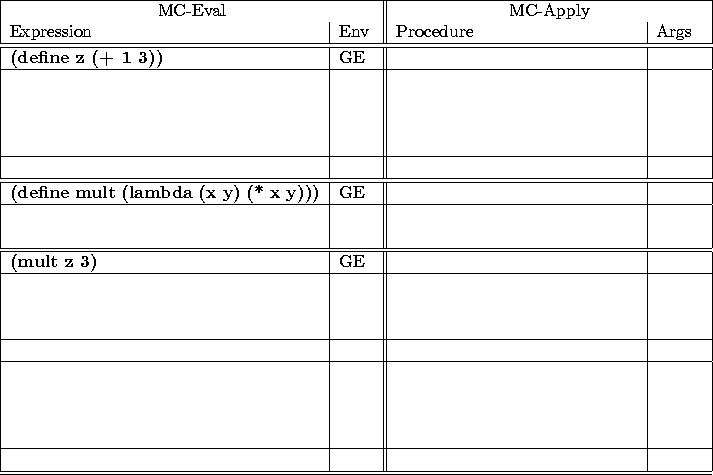



MASSACHVSETTS INSTITVTE OF TECHNOLOGY
Department of Electrical Engineering and Computer Science
6.001---Structure and Interpretation of Computer Programs
Spring Semester, 1999
Recitation -- Friday, April 9
The heart of the Scheme language is an interpreter, that is, a process that evaluates legal expressions of the language. In lecture, we saw a Scheme interpreter built around the use of two basic procedures, which we will call mc-eval and mc-apply. Examples of these, without data abstractions, are given below:

(define (mc-eval exp env)
(cond ((number? exp) exp) ;base case for numbers
((symbol? exp) (lookup exp env)) ;base case for variables
((eq? (car exp) 'quote) (car (cdr exp))) ;special forms
((eq? (car exp) 'lambda)
(list 'procedure (cadr exp) (caddr exp) env))
((eq? (car exp) 'define) (eval-define (cdr exp) env))
(else (mc-apply (mc-eval (car exp) env) ;procedure application
(list-of-values (cdr exp) env)))))
(define (mc-apply proc args)
(cond ((atom? proc) (apply proc args)) ;primitive case
((eq? (car proc) 'procedure) ;compound procedure
(mc-eval (caddr proc) ;procedure body
(extend-environment (cadr proc) ;formal parameters
args ;supplied arguments
(cadddr proc)))) ;saved environment
(else (error "Unknown procedure"))))
(define (eval-define exp env)
(define-variable! (cadr exp)
(mc-eval (caddr exp) env)
env))
(define (define-variable! var val env)
(set-car! (car env) (cons var (caar env)))
(set-cdr! (car env) (cons val (cdar env))))
(define (extend-environment vars vals base-env)
(cons (make-frame vars vals) base-env))
(define (make-frame vars vals) (cons vars vals))
Use the table below to trace what the Meta-Circular Evaluator does on the following three expressions. Also, use the space below the table to draw the mc-evaluator's environment.
(mc-eval '(define z (+ 1 3)) the-global-environment) (mc-eval '(define mult (lambda (x y) (* x y))) the-global-environment) (mc-eval '(mult z 3) the-global-environment)

Draw the mc-evaluator's environment diagram for evaluating the above expressions.
Draw the box-and-pointer diagrams that represent the mc-evaluator's environment.
Often we will want to add a special form to our evaluator. For example, say we want to add let. In general to add a special form, follow these steps.
What is the form of a let?
(let ((
) ... (

))
)
You can think of let as a data-abstraction that holds three things: A list of variables, a list of expressions, and a body. We need to write the selectors for this abstraction.
(let? '(let ((a (+ 3 4)) (b 5)) (+ a b))) ==> #t (let-variables '(let ((a (+ 3 4)) (b 5)) (+ a b))) ==> (a b) (let-exps '(let ((a (+ 3 4)) (b 5)) (+ a b))) ==> ((+ 3 4) 5) (let-body '(let ((a (+ 3 4)) (b 5)) (+ a b))) ==> (+ a b)
Write the code for the following selectors:

Write eval-let by desugaring:
(define (eval-let exp env) )
Write eval-let without desugaring:
(define (eval-let exp env) )
1. Write a scheme expression that prints itself.
(Hint: Consider how a cell reproduces. It contains its own blueprint (the DNA strand in the nucleus); reproduction involves (a) copying the blueprint, (b) implementing the blueprint. That is, it uses the blueprint twice.)
Write a scheme expression that goes into an infinite loop without using a define, let, or set!
Write a lambda expression that, when applied to a number, computes the factorial of that number without using define, let, or set! (Hint: Answer #2 first!).
Write the procedure list without using list or cons. (This should produce a real scheme list.)
Write the procedure car without using car.
Write the procedure cdr without using cdr.
Write map using accumulate (no recursion).
Write filter using accumulate (no recursion).


